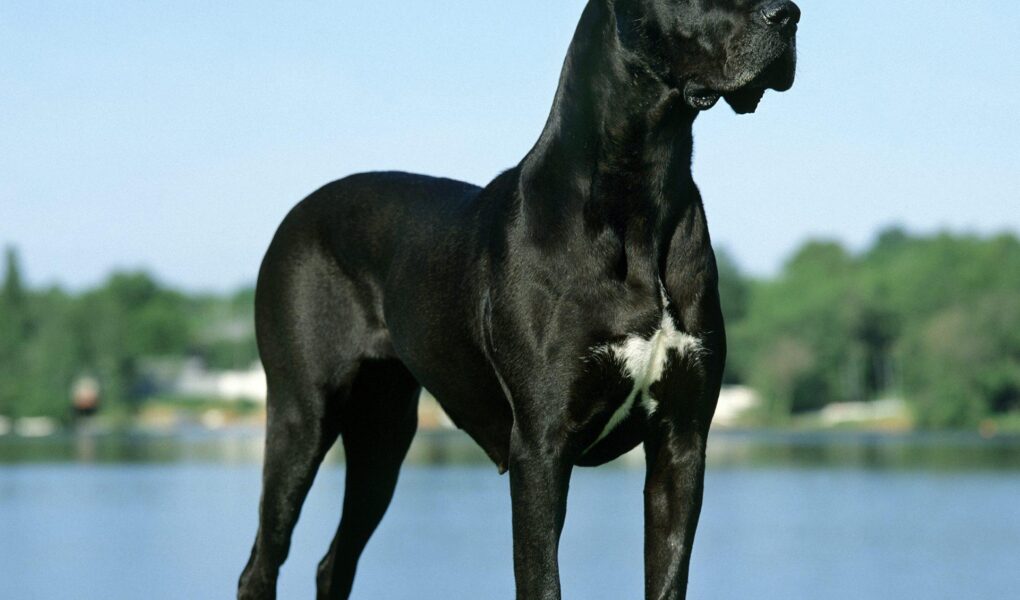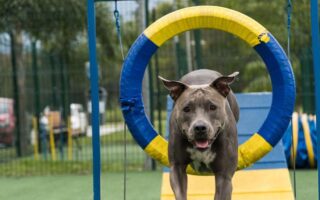Title: A Gentle Giant’s Journey: Training Your Great Dane
Introduction:
In the realm of canine companions, few breeds evoke as much awe and admiration as the Great Dane. With their towering stature and graceful demeanor, these gentle giants command attention while endearing themselves to families around the world. However, beneath their imposing exterior lies a heart that thrives on companionship, loyalty, and a desire to please. Training a Great Dane may seem daunting at first glance, given their sheer size and strength, but the journey is as rewarding as it is essential. Effective training not only fosters good behavior but also strengthens the bond between you and your furry friend, transforming a massive breed into a well-mannered member of your family. In this article, we’ll explore essential training techniques, tips, and insights that will help you navigate the path to raising a happy, confident, and obedient Great Dane. Whether you’re a seasoned dog owner or a first-time trainer, the adventure of guiding your giant through the nuances of obedience and socialization awaits.
Table of Contents
- Understanding the Unique Temperament of Great Danes
- Essential Training Techniques Tailored for Giant Breeds
- Positive Reinforcement Strategies for Successful Learning
- Socialization Best Practices for a Well-Rounded Great Dane
- Q&A
- In Retrospect
Understanding the Unique Temperament of Great Danes
Great Danes possess a unique blend of qualities that contribute to their distinct temperament. Known for their gentle giant persona, these dogs exude a calm and friendly demeanor that makes them excellent companions. Their natural instinct to protect their families, paired with their affectionate nature, allows them to form deep bonds with humans and other animals alike. While they may appear intimidating due to their size, Great Danes are often gentle and patient, especially around children. Their social and easygoing nature makes early socialization crucial to developing a well-adjusted adult dog.
To better understand and train a Great Dane, it is vital to recognize their intelligence and eagerness to please. Here are some characteristics that highlight their temperament:
- Affectionate: They thrive on companionship and love being around their families.
- Protective: They have a natural instinct to guard their home without being overly aggressive.
- Calm: Despite their size, they are often surprisingly laid-back.
- Playful: Great Danes enjoy playtime, demonstrating their fun-loving spirit.
Understanding these traits will allow you to tailor training methods that resonate with their personality. Here’s a brief table showcasing ideal training methods suitable for Great Danes:
| Training Method | Description |
|---|---|
| Positive Reinforcement | Using rewards such as treats or praise to encourage desired behaviors. |
| Consistent Commands | Using clear and consistent commands helps them understand expectations. |
| Socialization | Exposing them to various environments and other dogs to build confidence. |
Essential Training Techniques Tailored for Giant Breeds
Training a Great Dane requires an approach that takes their size and temperament into consideration. Consistency is key, along with positive reinforcement methods that encourage good behavior while fostering a loving bond between the dog and its owner. To effectively train your giant breed, consider the following techniques:
- Positive Reinforcement: Use treats, praise, and affection to reward desired behaviors.
- Short, Focused Sessions: Keep training sessions brief, about 5-10 minutes, to maintain their focus.
- Socialization: Introduce your Great Dane to various environments, people, and animals to build confidence.
- Leash Training: Given their size, start leash training early to instill good walking habits and prevent pulling.
Understanding your Great Dane’s body language is equally essential. By observing cues such as tail wagging or ear positioning, you can tailor your training effectively. Consider this table to help recognize and interpret their signals:
| Body Language | Meaning |
|---|---|
| Relaxed Posture | Feeling comfortable and at ease. |
| Paw Lifting | Curious or undecided; may need encouragement. |
| Barking or Growling | Alert or protective; assess the situation. |
| Tail Between Legs | Scared or anxious; offer comfort and support. |
Positive Reinforcement Strategies for Successful Learning
Implementing effective reinforcement strategies is essential when training a Great Dane, as this breed thrives on positive interactions. By using rewards that resonate with your dog, you can foster a love for learning and cooperation. Here are some effective reinforcement techniques:
- Verbal Praise: Use enthusiastic tone and encouraging words when your dog successfully follows a command.
- Treats: High-value treats can be used to reward good behavior. Choose small, delicious snacks that your Great Dane can savor.
- Playtime: Incorporating play as a reward reinforces training sessions. Tossing a favorite toy can motivate your dog to perform.
- Affection: Physical touch, like belly rubs, can create a strengthened bond between you and your dog, making training feel rewarding.
Incorporating these strategies into your training routine not only enhances the learning experience but also builds trust. It’s important to maintain consistency, ensuring that your dog learns to associate positive behaviors with rewards. Consider creating a small chart to track your Great Dane’s progress, which reinforces the notion of achievement:
| Command | Status | Reward |
|---|---|---|
| Sit | ✅ Completed | Treat & Praise |
| Stay | ✅ Completed | Toy & Play |
| Come | ✅ Completed | Affection & Treat |
Socialization Best Practices for a Well-Rounded Great Dane
When it comes to socializing your Great Dane, early and consistent exposure to various environments is vital. It is essential to introduce them to different people, places, and other animals to help them develop into well-adjusted adults. Begin by exposing your pup to a variety of sounds, sights, and situations, such as busy streets, parks, and pet-friendly stores. Engaging in puppy classes can also provide a safe space for your Great Dane to learn how to interact appropriately with new friends. Remember that positive reinforcement is key; reward good behavior with treats and praise to encourage a confident demeanor in various social situations.
Additionally, maintaining regular playdates with dogs of various sizes and temperaments allows your Great Dane to practice their social skills. It’s important to supervise these interactions, especially with smaller dogs, as Great Danes can be a bit clumsy due to their size. Here are some socialization tips to keep in mind:
- Start socializing at an early age, ideally by 7-8 weeks.
- Visit different environments frequently to expose them to new experiences.
- Enroll in puppy training classes to meet other dogs and people.
- Use positive reinforcement to build trust and comfort.
- Be patient and consistent; socialization is an ongoing process.
Q&A
Q: What makes Great Danes unique when it comes to training?
A: Great Danes are known for their imposing size and gentle temperament, which can make training both a rewarding and challenging experience. Their intelligence and eagerness to please are assets in training, but their size means that consistency and control are essential to ensure they respond appropriately. It’s important to keep in mind their sensitive nature; harsh training methods can lead to anxiety or fearfulness.
Q: At what age should I begin training my Great Dane?
A: Training should start as early as possible. Beginning socialization and basic commands around 8 weeks old sets a solid foundation. Puppy classes are an excellent way to introduce them to various stimuli and other dogs. Remember, while they may grow quickly, their mental development takes time, so patience and positive reinforcement are key.
Q: What training methods work best for Great Danes?
A: Positive reinforcement is the most effective method for training Great Danes. This includes rewarding them with treats, praise, or play whenever they successfully follow a command or display good behavior. Utilizing clicker training can also be very effective, as it allows for precise communication of desired behaviors. Keep sessions engaging and fun to maintain their interest and motivation.
Q: How can I manage my Great Dane’s size during training?
A: Managing a Great Dane’s size is crucial in training, as their strength can be overwhelming. Start with leash training from a young age to teach them to walk nicely beside you. Using a well-fitted harness can provide better control while avoiding any discomfort to their neck. Practicing commands such as “sit” and “stay” can also help establish boundaries and ensure they don’t inadvertently knock things over with their enthusiasm.
Q: Are there specific challenges I should anticipate when training a Great Dane?
A: One major challenge is their tendency to become distracted, especially as puppies. Their curious nature means they often want to explore their surroundings, which can make focus a bit tricky. Consistent training in various environments can help them learn to concentrate despite distractions. Additionally, their growth spurts can affect their coordination, so be patient and adapt your training sessions to accommodate their physical development.
Q: How can I socialize my Great Dane effectively?
A: Socialization is critical for Great Danes to ensure they develop into well-rounded adults. Introduce them to different people, environments, and other animals in a controlled setting. Puppy parks can be helpful, but ensure that you monitor interactions to prevent overwhelming situations. Regular exposure to various stimuli will help them learn to remain calm and confident as they grow.
Q: Can Great Danes learn advanced commands and tricks?
A: Absolutely! Great Danes are capable of learning a variety of advanced commands and tricks. Once they have mastered basic obedience, you can move on to more complex tasks like “roll over” or “play dead.” Teaching them tricks not only stimulates their mind but also strengthens the bond between you. Keep sessions short and fun, mixing in different activities to keep their interest piqued.
Q: What are some common behavioral issues that might arise, and how can I address them?
A: Some common issues include jumping, excessive barking, or stubbornness. To address jumping, teach a consistent “off” command and reward them when they keep all four paws on the ground. For barking, identify the trigger and redirect their attention with a command or engagement in a different activity. If stubbornness becomes a pattern, revisit the basics, ensuring training is enjoyable and doesn’t feel like a chore for them.
Q: How important is ongoing training for my Great Dane?
A: Ongoing training is vital for maintaining good behavior throughout your Great Dane’s life. Regular practice helps reinforce what they’ve learned and strengthens your communication. This doesn’t have to be formal; incorporating training into daily activities and having fun with it helps keep their skills sharp. Plus, it provides mental stimulation, which is important for their overall well-being.
In Retrospect
As we conclude our exploration of Great Dane training, it’s clear that nurturing a bond with these gentle giants goes beyond mere commands and obedience. Any journey with a Great Dane is not just about instilling discipline; it’s about cultivating trust, understanding, and respect. With patience as your guide and consistent practices as your tools, you’ll not only shape a well-mannered companion but also create a steadfast friendship that can withstand the test of time. Remember, each Great Dane is unique, and embracing their individuality can lead to the most rewarding experiences. Whether your Dane is a playful puppy or a dignified adult, take each training session as an opportunity to learn and grow together. So, forge ahead with confidence, and revel in the joy of sharing your life with a truly remarkable breed. Happy training!



